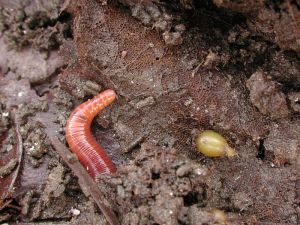A great writeup for anyone interested in vermiculture!
![]() Early drawing of Eisenia fetida (source).
Early drawing of Eisenia fetida (source).
Many of us dissected worms in biology class and most have used them for fishing bait, but few know much about the lives of Eisenia fetida. Called “red wrigglers” by composters or “panfish” or “trout worms” by others, they belong to the Lumbricidae family of earthworms and are the only worms you should consider using in a compost bin. I did try this once with other types of worms, but it failed and we came home to find escaped worms all over the floor.
Reproduction
 Red Wriggler and cocoon (source).
Red Wriggler and cocoon (source).
Worms are hermaphroditic, that is, they are both male and female, however, they do require a partner for reproduction. Adult worms line up their clitella (the light-colored band near their front third; some call these worms “banded” worms because of this ring) with their partner’s genital openings and exchange…
View original post 297 more words

Check out our whole series on vermicompost: https://lowtechinstitute.org/category/series/vermicompost-101/
Thanks for sharing!
LikeLiked by 1 person